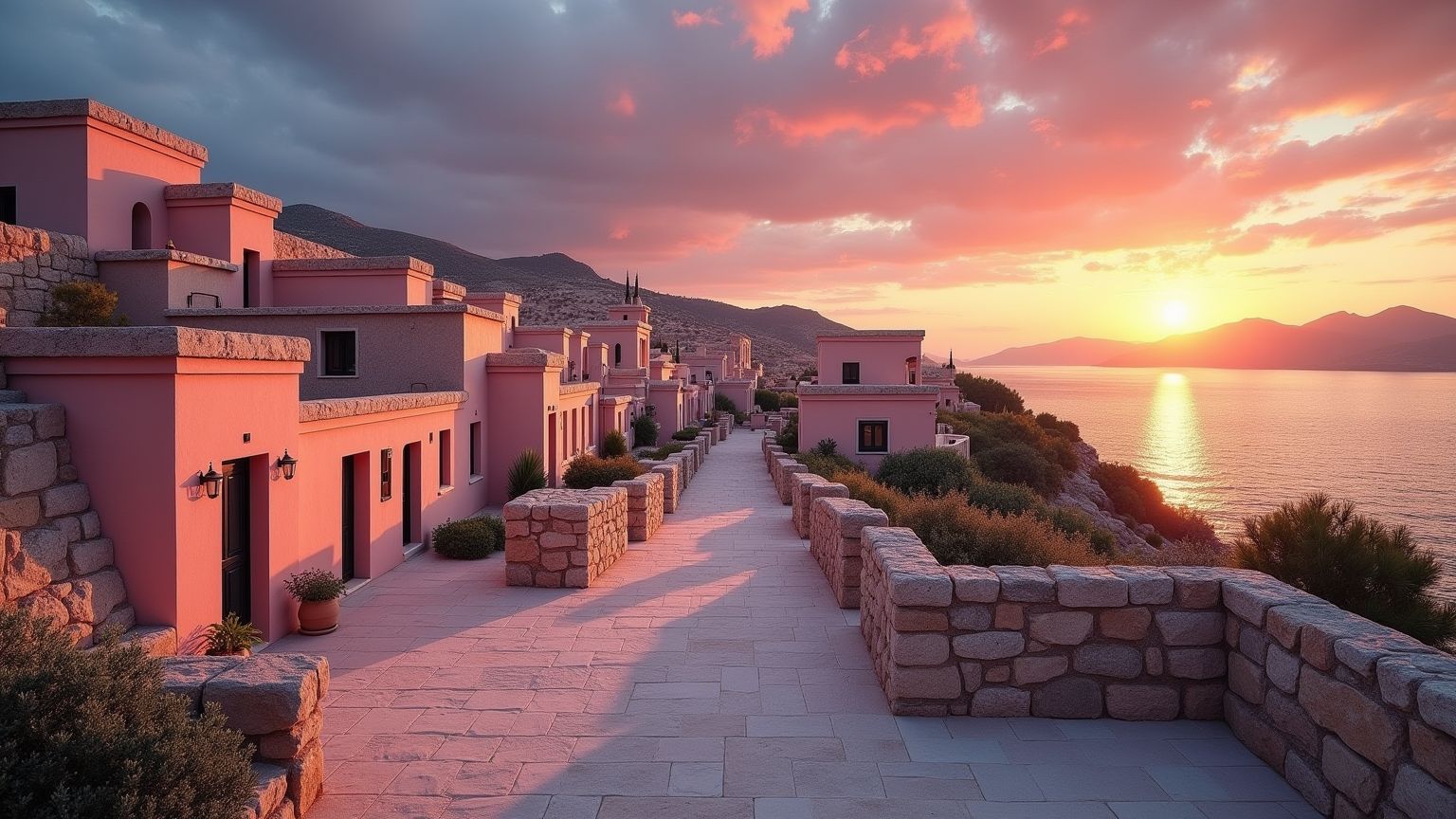Epidaurus: A Journey Through Time to Ancient Greece’s Healing Sanctuary
After twenty-odd years of shepherding wide-eyed travelers through Greece's ancient wonders, I've watched a particular kind of magic unfold when folks first stand in Epidaurus's legendary theater. Their faces do this thing—a mixture of disbelief and wonder that no camera ever quite captures. There's an electricity in the air there, something that buzzes through your bones when you stand where healers and patients stood thousands of years ago.
Let me spill the tea about Epidaurus—not as some dry historical lecture, but as someone who's walked its stones so many times they practically say hello.
The Historical Significance of Epidaurus
Tucked into the northeastern Peloponnese peninsula like a precious stone in Greece's crown, Epidaurus wasn't just another dot on the ancient map. This place was the wellness retreat of the ancient world—the birthplace of holistic healing when that wasn't even a concept yet.
The Sanctuary of Asklepios at Epidaurus was basically the Mayo Clinic of antiquity, but with better views and more interesting therapy options. While we're busy building sterile hospital rooms with fluorescent lighting, the ancient Greeks at Epidaurus were pioneering the radical idea that healing should nourish your entire being.
The sanctuary's glow-up began around the 6th century BCE, hitting its stride in the 4th and 3rd centuries when it became THE place to heal. Picture ancient travelers dragging themselves across the Mediterranean—no TripAdvisor reviews or air conditioning—desperate to meet Asklepios, medicine's divine rockstar.
What makes Epidaurus so mind-blowing even today is how they mashed together practical medical treatments with:
- Dream therapy sessions
- Theatrical performances as medicine
- Religious rituals that calmed the mind
- Physical exercise regimens
When you wander through this UNESCO World Heritage site, you're not just looking at old rocks—you're walking through the birthplace of the radical notion that beauty, harmony, and peaceful vibes might actually help heal your body. Modern wellness influencers think they invented this stuff—ha! Epidaurus was doing it when people still thought the world was flat.
Getting to Epidaurus: Your Journey Options

The question I get hammered with constantly: "How the heck do we get to Epidaurus?" Good news—you've got options that don't involve time travel or ancient pilgrimages.
From Athens by Car
This is my go-to recommendation. Grab a rental in Athens and take a gorgeous 2-hour drive (about 135km) that'll have you making embarrassing noises at the Saronic Gulf views. Follow the National Road to Corinth, then cruise the coastal road toward Epidavros.
My insider tip that I usually save for friends: Get your butt out of Athens before 8:30 AM. Not only will you dodge the Athens traffic nightmare, but you'll hit Epidaurus before the tour bus armies invade and before the sun turns the site into a beautiful but merciless frying pan.
By Public Bus
Watching your drachmas? KTEL buses roll from Athens to Epidaurus regularly. They leave from Terminal A at Kifissos Bus Station, take roughly 2.5 hours, and set you back about €15-20 one way.
Word of warning from someone who's had to rescue stranded tourists: The last bus back to Athens typically vanishes by mid-afternoon. Check that return schedule like your dinner depends on it—because it might!
Organized Day Tours
For the "I just want someone else to handle everything" crowd, tour companies will happily exchange €85-120 of your money for a day trip that usually bundles Epidaurus with Mycenae and sometimes throws in charming Nafplio.
Having led enough of these tours to recite the spiel in my sleep, I'll tell you what the brochures won't: these tours typically give you a measly 1-2 hours at Epidaurus itself. That's like trying to "experience" Paris by running past the Eiffel Tower while someone shouts facts at you.
Staying Nearby (The Insider Move)
Want to experience Epidaurus the way I'd show my own family? Base yourself in either Ancient Epidavros—a seaside charmer about 30 minutes from the site—or elegant Nafplio, arguably Greece's most romantic city, about 40 minutes away.
This genius move lets you visit Epidaurus during the magical hours—early morning when the light turns the limestone honey-gold, or late afternoon when the day-trippers have retreated and the theater seems to exhale in relief.
What to See: The Marvels of Epidaurus
When visitors corner me demanding a checklist of "must-sees" at Epidaurus, I always pause. This isn't a scavenger hunt of ancient debris—it's about understanding a healing ecosystem where every structure played its part in a holistic wellness journey that makes our modern spa retreats look pathetically unambitious.
The Ancient Theater
The undisputed heavyweight champion of Epidaurus is its theater, dreamed up by Polykleitos the Younger back in the 4th century BCE. This 14,000-seat masterpiece isn't just "well-preserved"—it's downright supernatural.
Stand at the orchestra's center and whisper something—anything. Your friends in the nosebleed section, a full 60 meters away, will hear you clear as day. This acoustic miracle wasn't some happy accident but the result of mathematical precision that modern architects still geek out over.
The theater's 55 rows of limestone seating create a perfect semicircle, with 34 rows in the lower tier and 21 up top. The Greeks weren't just building a venue; they were crafting visual poetry in stone, expressing their obsession with perfect proportions.
If you time your visit during the annual Epidaurus Festival (June through August), you can watch ancient Greek tragedies performed under a canopy of stars, exactly where they were staged 2,400 years ago. It's the kind of goosebump-inducing experience that makes people write terrible poetry afterward. Book tickets early—this isn't a secret anymore.
The Sanctuary of Asklepios
Beyond the showstopper theater lies Epidaurus's actual heart: the Asklepieion. This wasn't just a hospital—it was a healing wonderland with specialized buildings for different stages of getting well:
The Temple of Asklepios anchored the whole complex and once housed a gold-and-ivory statue of the healing god that would make Fort Knox jealous. Only the foundations remain, but standing there helps you imagine ancient patients praying for divine intervention.
The Abaton was Epidaurus's dream therapy center—literally. Patients would sleep here believing Asklepios would slide into their dreams with a personalized diagnosis or cure. Before hitting these sacred bunk beds, visitors underwent purification rituals designed to put them in a receptive state. Ancient psychology at work!
The Tholos is a circular mystery wrapped in marble. With its concentric black and white floors and bizarre underground maze, scholars think it housed Asklepios's sacred snakes that slithered over patients during healing rituals. (Ancient healthcare was... different.)
The Stadium hosted athletic competitions because the Greeks figured out thousands of years before Peloton that moving your body might actually be good for you.
The Archaeological Museum
After trudging through sun-baked ruins, the air-conditioned museum is both a relief and revelation. Here you'll find surprisingly sophisticated surgical tools that'll make you grateful for modern anesthesia, along with architectural fragments and gifts left by healed patients.
The collection's crown jewels are the "iamata"—stone tablets recording successful cures attributed to Asklepios. Reading these ancient testimonials is like browsing a medical Reddit from 300 BCE: "Snake licked my blind eye, now I can see!" and "Dreamed the god cut open my belly, woke up cured of stomach pain!"
Visitor Practicalities: Making the Most of Epidaurus
Best Time to Visit
After roasting myself through countless Greek summers while explaining the site to sweaty tourists, I can report with authority: aim for late May to early June or September to October. You'll get pleasant temperatures, thinner crowds, and lower prices in nearby towns.
July and August bring the theater festival's magic but also hordes of tourists and heat that makes you question your life choices. If summer's your only option, explore early morning or late afternoon unless being slow-roasted while squinting at ruins is your idea of fun.
Winter visits offer a more contemplative, almost mystical experience with Epidaurus. You might have the entire theater to yourself—just bring layers and watch the weather.
Opening Hours and Tickets
Epidaurus typically welcomes visitors from 8:00 AM to 8:00 PM in summer (April-October) and 8:00 AM to 5:00 PM during winter (November-March). But these hours can shift like Greek politicians' promises, so check the official Hellenic Ministry of Culture website before trekking out.
A full-price ticket runs €12, with the usual discounts for students, seniors, and other special categories. The smart move is grabbing the €20 combo ticket that also gets you into nearby archaeological superstars like Mycenae.
What to Bring
After countless sunburns and emergency water runs for dehydrated tourists, here's my Epidaurus survival kit:
- Sturdy shoes with decent grip (those theater steps get slicker than a politician's promises when worn smooth)
- A proper hat that covers your ears and neck (not those useless visors)
- Industrial-strength sunscreen (the Greek sun doesn't mess around)
- More water than you think reasonable (there's a refill station at the visitor center)
- A light jacket for evening performances (yes, even in summer—the temperature drop can be shocking)
- A small notebook (something about Epidaurus makes even the least poetic visitors suddenly philosophical)
- Binoculars for spotting architectural details and creeping on theater performances
Beyond the Main Attractions: Hidden Gems of Epidaurus
Most visitors do the theatrical equivalent of a drive-by shooting—they snap their theater photos and vanish. But Epidaurus hides secrets that most tour guides (the lazy ones, not me) never mention:
The Western Cemetery
A peaceful stroll from the main sanctuary brings you to a hillside dotted with tombs spanning centuries. From simple stone boxes to family crypts with room service (okay, just elaborate decoration), these graves tell us how attitudes toward death evolved from "terrifying inevitability" to "spiritual transition."
The Propylaia
The sanctuary's grand entrance wasn't just practical—it was psychological. Walking through this gateway, ancient visitors physically and mentally crossed from the ordinary world into sacred space. The detailed carvings here speak volumes about the theatrical nature of ancient healing.
Ancient Epidavros Town
Half an hour's drive away, the sleepy port of Ancient Epidavros (Archaia Epidavros) hides its own mini-theater and city ruins. After exploring, grab a table at one of the harbor tavernas where local fishermen deliver the day's catch directly to the kitchen. The grilled octopus here has made grown men weep with joy.
Cultural Context: Understanding the Epidaurus Experience
To truly get Epidaurus, you need to ditch modern thinking that separates medicine, spirituality, and art into different departments. For the ancient Greeks, these weren't separate channels—they were all playing the same healing symphony.
A visit to Epidaurus wasn't just "going to the doctor." It was a multi-day wellness retreat that went something like this:
- Purify yourself (both physically and spiritually)
- Make offerings to Asklepios (hedging your divine bets)
- Watch emotional theatrical performances (ancient psychotherapy)
- Exercise in the gymnasium (physical therapy, Greek-style)
- Eat prescribed foods (the original elimination diet)
- Sleep in the Abaton hoping for a divine dream diagnosis
When you visit Epidaurus today, try experiencing it as this integrated healing machine rather than a collection of old buildings. Notice how buildings align with the sunrise, how certain spaces create feelings of awe or intimacy, how the entire complex nestles into the landscape like it grew there naturally.
Conclusion: The Timeless Magic of Epidaurus
Even after two decades of visits, Epidaurus still sometimes stops me mid-sentence when the light hits the theater just right or when I catch the scent of wild herbs on the breeze—the same herbs healers might have used thousands of years ago.
Epidaurus isn't just some dusty archaeological checkbox. It's a place where humans figured out that healing requires addressing the whole person—body, mind, and spirit—in surroundings designed to elevate and inspire.
Whether you're a history buff, architecture nerd, acoustic engineer, theater lover, or just someone seeking a moment where time seems to fold in on itself, Epidaurus delivers. The genius of this place is that it speaks to something timeless in us—our desire for wholeness, our appreciation of beauty, and our hope that somewhere, somehow, there might be healing for whatever ails us.
This ancient sanctuary reminds us that perhaps our ancestors weren't so primitive after all—that in their integration of medicine, art, and spirituality, they might have understood something about healing that our specialized modern world has forgotten. Standing in the perfect acoustics of Epidaurus's theater, that ancient wisdom doesn't just echo—it resonates.








